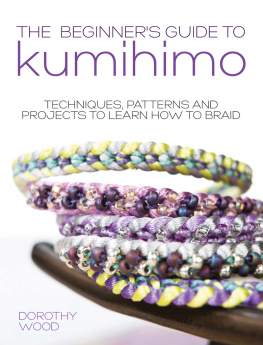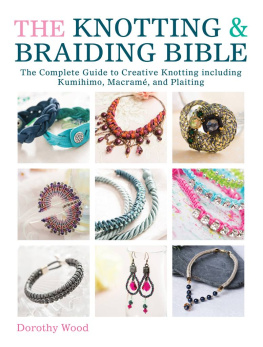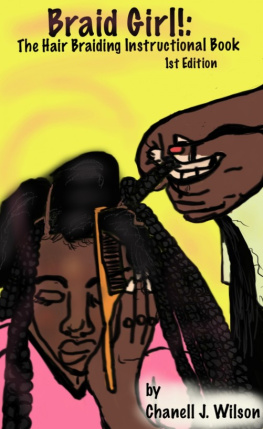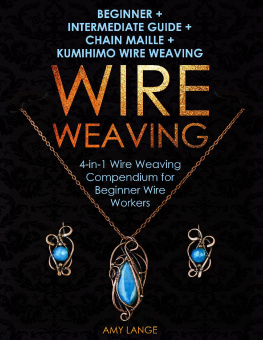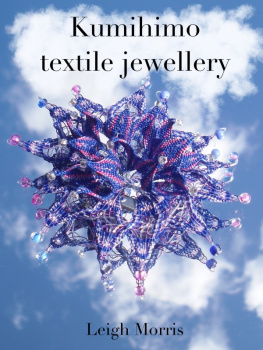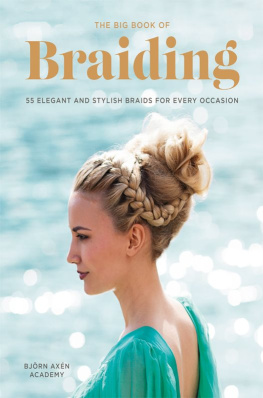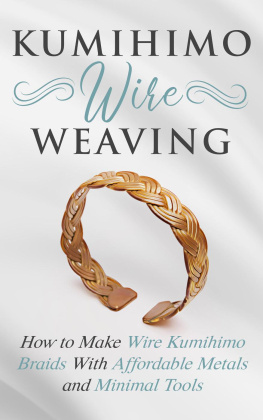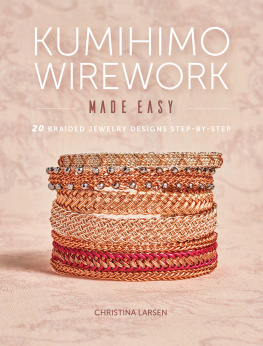Contents
Guide
THE BEGINNERS GUIDE TO
kumihimo
TECHNIQUES, PATTERNS AND PROJECTS TO LEARN HOW TO BRAID
DOROTHY WOOD

www.stitchcraftcreate.co.uk
CONTENTS
KUMIHIMO
Kumihimo is a braiding technique originating from Japan the name means gathered threads in Japanese and it is traditionally worked on wooden stool-shaped structures called Marudai, which are beautiful but expensive. Kumihimo disks and plates made from a lightweight dense foam are more affordable for beginners and occasional users, and can be used to make a wide variety of different-shaped braids using one or more of six basic moves that either pass the cords over the centre hole or around the edge of the disk or plate.
Equipment and Materials
Traditionally Kumihimo braids were made on a Marudai and worked with bundles of fine silk threads to make an obi-jime, the belt worn around a kimono. Contemporary braiders can choose instead to work Kumihimo using the versatile and very portable disk or plate, using a variety of readily available cords, threads or even wire.
Kumihimo tools
It is essential to have a disk or Marudai to work Kumihimo, so review the options and decide whether you want to go down the traditional route or to start simply with a disk or plate.
Disk and plate
These simple tools are made from dense foam with numbered slots for the cords or thread (see ). The disks have slots all round with numbers from 1 to 32 (the number refers to the slot on the left as you move clockwise). The square plates have numbers along the top and bottom edges, distinguished either with a circle on the bottom row or a different set of numbers. There are letters down each side either with lower case and capitals or a circle on one set. The round disk can be used for both round and flat braids but you may find it easier to use the square plate for flat braids as it has a rectangular hole in the middle.
Marudai
Unlike the Kumihimo disk or plate, the Marudai (round stand) has no numbers to guide you or slots to secure the cords or threads. It is still the same basic technique but you do need more equipment to get started. It is essential to create a balance between the cords and braid using weighted bobbins and counterweights (see ). You are not restricted to a particular number of slots with a Marudai and, as it is free-standing, the braid is worked with two hands, making it a very relaxing and rhythmic way to work Kumihimo.
Traditionally flat woven braids are worked on a Takadai, which is the flat braid version of a Marudai but with a much larger more cumbersome frame.
Bobbins
It is fairly easy to work Kumihimo braids with cords up to about 75cm (30in), but when working with longer cords, you will find it much easier to wind the cord onto little bobbins. You can use cotton reels or even a piece of folded card, but these specially designed bobbins are inexpensive with a stopping mechanism inbuilt to secure the cords. Marudai bobbins are available in a range of different weights.
Wire for Kumihimo
Wire can be used for any Kumihimo braid provided that it is soft enough or thin enough to be manipulated successfully. It has to withstand being bent back and forwards without breaking or becoming harder.
What wire?
Wire is available in a range of cross sections but round is generally the most successful for Kumihimo; 0.315mm (30swg) cut into bundles of four strands is a good way to start. You can incorporate wire into bundles of thread to make a braid that will hold its shape when bent or add beads to thicker wire to make beaded bangles.
Copper or copper-core wires
Craft jewellery wire is ideal for Kumihimo braiding.

Aluminium wires
As these are very soft, you could use a thicker diameter, but take care as they can be brittle if overworked.
Silver wire
That sold as soft condition is suitable for braiding.
Weights
Weights are traditionally used with the Marudai to counterbalance the weight of the bobbins (see ); the centre-weight, which can be a bag filled with coins, should be equal to half the combined weight of the bobbins. The Kumihimo disk and plate have slots so it is not necessary to use a weight as the slots keep the cords or threads in place, but I have found that round braids in particular are smoother and more even when a centre-weight of about 70100g (212312oz) is used (thicker cords will need a slightly heavier weight than thinner cords).
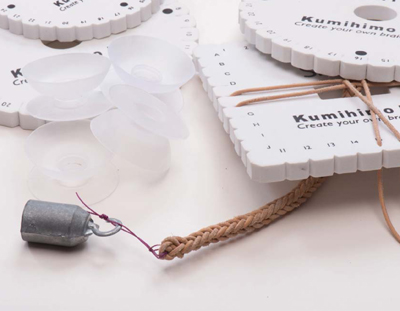
Equipment for getting started with Kumihimo is relatively inexpensive. A disk or plate, some bobbins and a weight are all you need.
Cords and threads for Kumihimo
Kumihimo can be worked using any material that can be bent and manipulated into a braid. Traditionally fine silk cords are used but there are many more options.
Thick or thin?
Japanese braiders use bundles of fine silk thread to work Kumihimo. Typically each bundle has 40 threads and so, although the thread is fine like a sewing thread, the bundles themselves are quite thick. To work traditionally, silk or imitation silk threads such as Shinon or Biron can be bought pre-cut in lengths approximately 3m (3yd) long. But there are many more options available to you, from a fine embroidery thread to a thick rattail or leather cord. You can also combine different thicknesses of cord or thread in the same braid to create different textures or to add beads (see ). There is no particular restriction on thread/cord size when using a Marudai, but with the disk or plate they have to be thin enough to fit into the slots.
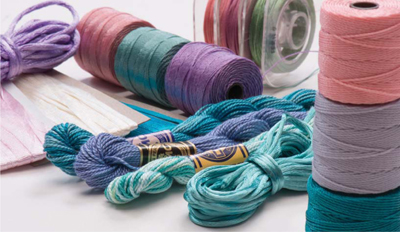
Silk thread Group in bundles for strong braids that have a fabulous sheen; silk embroidery thread is also suitable.
Satin cord A beautiful cord with a high sheen ideal for Kumihimo and available in a range of thicknesses.
Chinese knotting cord Suitable for making textured braids, this round cord has a centre core so stays round when braided.
Superlon This twisted nylon cord makes stiff Kumihimo braids, and is perfect for adding beads or working around a core. You can make a fine braid using Superlon cord only or mix it with other cords such as rattail to create different textures.
Embroidery threads The subtle sheen of stranded cotton (floss) and cotton perl for example, produce a matte finish on braids; metallic embroidery threads add a touch of sparkle.
Ribbons and flat braids Ideal to bring a change of texture to your Kumihimo braids; look out for tubular mesh ribbons, either synthetic or metal.
Ribbon works particularly well for techniques where some cords are not braided every time, to give you longer strands on the outside of the braid (see ).

